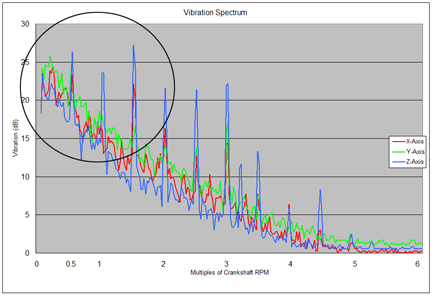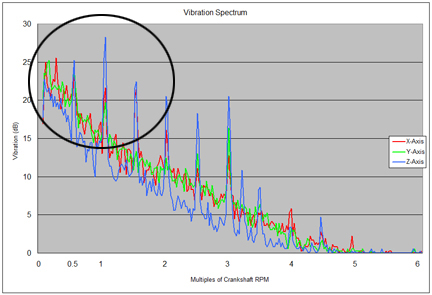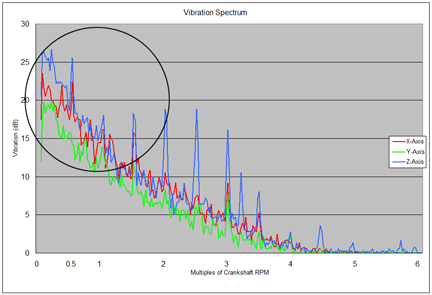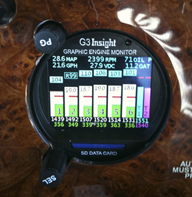Pilot Feedback
Just back from my flight with the new software and all I can say is WOW!
The %HP fix is perfect.....so now the LOP and ROP pilots are both happy.
Also, the probe diagnostic screen was very stable with no flashes of red at al.
I am going to play with the "Live G Force" screen a bit more to fully understand it but it seems like it is a great addition to already great product.
I'm not totally clear yet on the difference between this screen and the vertical component of the 2 axis turbulence screen.
It seems both are going the vertical component in Gs. It is really amazing to see the great changes that keep coming to the G series analyzer.
When Insight says it is the only engine analyzer that keeps getting better, it is the truth!!!
I plan to post all the new additions on the Socata Website today.
Larry Levin
Hey Zoltan,
I'm sure you'll be interested in the fixing
of the 'leaning problem' on our 1968 Cessna
Cardinal with the G1 installed. We talked
about it over the phone last year. If you
recall, when we leaned, the temps continued
to rise, even at the point of the engine
cutting out. We looked for manifold leakage,
carb problems, even changed the jet to a
larger size... no luck.
We noticed very little rpm drop when pulling
carb heat during run-up, not the smoothest
running in the air. While troubleshooting we
noticed the engine ran smoother on ground
with lower cowl off and, we got that little
rpm rise just as the engine was shutting
down that had always been missing.
Finally led us to open the carb heat box on
the lower cowl and there it was. Someone had
rebuilt the flapper directing the heat
either overboard or to the carb. Terrible
job, but, the main problem was the geometry
between the Carb heat cable and the 'arm' it
was attached to which moved the heat valve.
It was not possible to close the valve so
even though' the lever was pushed all the way
in, the carb heat was still 1/2 open at all
times.
Of course this meant we were running with a very rich mixture, not because of high fuel that could be controlled with mixture but because of lack of sufficient air due to the high tem,phot air. In effect the mixture control was cutting off the fuel and we still were not at best fuel/air ratio.
We rebuilt the valve and re-welded the arm so the geometry works, held our breath and... run up perfect, good drop with carb heat check, engine very smooth now in flt, leaning works as advertised.
Thought you'd like to know...
Cheers
Jack Bannon
Subject: Feedback on G2 purchase
I wanted to give your company some quick feedback on my
recent purchase and installation of your G2 GEM in my
Piper Cherokee 140 with the Lycoming O-320-E2A power
plant. I was fortunate to be able to place my
order at Oshkosh.
Your sales and technical staff were outstanding and very
knowledgeable.
The product when it arrived was as advertised and the
installation went without any problem.
On my very first flight the instrument paid for itself.
The CHT indicator for one of my cylinders indicated a
hotter than normal temperature. With the data from
the G2 and some quick trouble shooting a leak in the
exhaust manifold at the cylinder head was discovered as
the culprit.
The leak was pointed toward the CHT probe and actually
heating the external surface of the probe. Left
unattended this could have really caused me some real
problems at the most importune time.
Again, thanks for a great product; I know that I'm going
to enjoy it for years to come.
Mr. Dave Barnhart

I appreciate you taking the time to answer. I am heading
out on a very long journey on July 20, and want to make
sure I fully understand how to use the G2 properly.
As a testimonial, after I installed the G2 last year, I took a long trip from Brampton to Baffin Island and around Hudson Bay. By using the G2 to fly lean of peak – 8 gph instead of 11 gph - I calculated that I saved about $950 in fuel on the one trip.
Chris Moon
Dear Zoltan,
App. 2 weeks ago I have called you to get an idea why
one of my 2 G3’s ignores all inputs coming from P2.
I expected to hear that this cannot be or that I made a
mistake when I spliced the connector, etc…
You brought in your engineer who explained how to open
the instrument and that there could be a bad connection
between 2 PCBs.
This was exactly the issue. I just had to connect the
boards and fit in the white plastic spacer. After
re-fitting the instrument in the panel, it worked
perfectly.
Thanks for your serious attitude towards your customers!
Thanks and best regards
Gerald
Subject: feedback
on G1
Yes please do post.
The more I use them the more I like them, excellent product.
This is one area where you guys are lacking. I was surprised that I could find precious little comment on the G series before purchasing.
I purchased based on study and my experience with my 610's.
I think if you had a web page dedicated to customer feedback it would be a great sales tool. I have to believe that the vast majority of your customers will have very positive comments.
I say vast majority because as you know there will be the occasional bone head that will be unhappy no matter what you do.
So you have to accept the bad with the good.
Just my 2 cents.
Thanks again,
best regards,
Jeff Carl
Hi Dan,
Well its like anything else it takes a while to get the hang of it. These are really great instruments!
What I have found is that with the increased precision, you really do need to have tuned injectors. No my situation worked out really well: I found a dirty injector on #4 on the left. Getting that cleaned up & moving a couple other injectors got me to within .4gph on the GAMI test.
On the right side after "musical injectors" I was able to get #1-4 all identical, with 5 & 6 peaking way too late (too rich). Those two have been sent to a shop that does a flow analysis & can lean them out to get them to peak with the others.
So next week when I'm all done I'll have each engine with matched fuel flow/peak egt. When pulling back the mixture I'll get all 6 peak boxes nearly simultaneously.
Of course
the other way to do that is to spend another
$800 per engine for GAMI injectors, but my case
worked out unusually well and that was not
necessary.
Thanks for
your help. It was very interesting, and at the
end I'll have much happier motors.
Jeff Carl
Cessna 310
Got it installed, and man do I love it.....noticed right
off the bat my #2 cylinder was running slightly cooler
on the egt's and discovered a minor intake leak.
The egt's are so quick to respond I even found what
spark plugs were less than perfect during the
run-up.....thoroughly impressed so far.
Install was pretty easy and straightforward.
I installed the G1 on my personal Comanche 250, but have
already recommended it to several others; I think an
engine monitor should be required equipment!
Paul Nickell, Owner
Advantage Aircraft
Services LLC
G3
vibration case study.
Question: Why would I want vibration analysis on an engine monitor?

Larry says:
"I had used the Excel
vibration graphing tool on Insight’s website to print
out the vibration analysis data from my G3 over a couple
of flights for a baseline benchmark.
After flying the G3 for 8
months I also had a new 3 bladed prop installed on my
Trinidad Socata TB20
After 90 hours I noticed
grease, and had to have the prop pulled and resealed. I
was told that the reseal would be covered under warranty
but that I did not need the prop balanced again.
It felt rougher to me,
however, so I printed out another vibration analysis
which confirmed more vibration after the re-seal than
before".
To: Insight
Subject: Balance
Hi Dan,
I am having my prop rebalanced this morning and will send you a new "after balance" chart as well as a couple more "before re-balance" charts later today. The shop tells me when they balance, they are correcting the vibration in the vertical axis only. I told them the Insight sensor measures in all 3 axis. Do you know if it is the X, Y or Z axis that correlates to the vertical that they are correcting?
Larry
To Larry
The Vertical axis is the Z Axis on our sensor. The Left-Right lateral axis is Y.
Because the prop spins in a plane defined by YZ, prop imbalance will contribute equally to Y and Z. X is Fore-Aft, and in theory would be relatively unaffected. Note that this definition depends on your sensor being mounted in the same orientation as the pictorial airplane on the sensor itself. If you've mounted it in some other orientation, you will have to translate it accordingly.
We look forward to examining the vibration spectrums.
Dan

Vibration data of new balanced prop (showing some imbalance)


Vibration data of rebalanced prop (a lot smoother as you can see; better than new)
Hi Dan,
The prop balance was completed and it
definitely feels much smoother. We went from .8 IPS to
.05 IPS. I have attached another "before" graph (I
believe I had sent you a couple previously) which was
taken today prior to the prop balance. The data was done
at 2500 feet at 65% power at 100 ROP. The "after" graph
was also taken today after the prop balance under the
exact same conditions.....2500 feet, 65% power and 100
ROP. The graph improvement for the Z average is pretty
dramatic as you can see.
I owe this
"warranty" prop balance to the evidence supplied by my
G3 prior to and after the prop reseal.
Larry
Conclusion:
A new balance was approved
under warranty.
Answer: A G3 color graphic
engine monitor is one of the few things you can put in
your aircraft that will actually pay for itself.
G3 Pilot Feedback
I recently
upgraded my Baron B55 from a GEM 1200 to two new Insight
G3 2.25" instruments. These color engine gauges take
engine management to a new level at a very affordable
cost. The upgrade used my existing probes and wiring for
the EGT and CHT sensors and reduced the time and cost of
the installation dramatically. I can now see the
temperature of every EGT and CHT simultaneously in
addition to the color coded bar charts on a crystal
clear LCD screen. The lean boxes that show the current
EGT variance from peak EGT make the leaning process very
simple and easy to monitor throughout the flight. On top
of that I get backup instruments for all other key
engine data to provide redundancy to my unreliable
legacy engine gauges. The Insight G3 instruments make
flying my plane even more fun and safer than ever.
Joe Lechman
1976 Baron B-55
"During my first flight with the G3, I very quickly
learned the value of the probe diagnostic functionality.
It turned out that this flight was also the first flight
with 6 new cylinders on my Cessna P210 so it was
intended to be a 2 hour, high power break-in flight On
the ground, during run-up, all my EGTs and CHTs looked
normal. However, 15 minutes into the flight, the #3 EGT
began to show odd and fluctuating temperatures. I was
flying with my mechanic and we both believed that we had
a probe issue but decided to head back to the airport
and land just in case it was something in the new
cylinder. Given our newness to the G3, neither of us
thought to look at the probe diagnostics page until we
were actually on final. Once it dawned on us that the G3
could tell us if we had a probe failure or not, a quick
glance at the probe diagnostic page showed the #3 EGT
probe at around 90 ohms resistance, an obvious failure.
The G3 made it very easy to spot as the data for that
probe was displayed in red. Now that we were confident
that we had a probe issue and not a cylinder issue, we
continued the flight, saving a complete cool-down cycle
on the new top end as well as the time to un-cowl and
diagnose the #3 EGT probe.
Interestingly, back on the ground after the flight, the
#3 EGT probe again showed 5 ohms. Clearly this probe was
only malfunctioning at high temperatures, making it very
difficult to diagnose on the ground. Insight has really
touted this feature and I have now had the real-world
experience to understand exactly why. Great job,
Insight!"
All the
best,
Jim Baum
N5447A
New Graphic Engine Monitor from Insight Avionics!
It's called the G3 and I have one. It is awsome! It
provides more information than you could possibly use
and it's only 2 1/4" in diameter! It is STC'd for the
Seabee so just put it in and send in the 337 form and
your done! Very reasonable price also. Excellent
customer service and tech support!
Check Out - http://www.republicseabee.com/
Zoltan,
I have some time flying behind the G3 at this time. I thought I would give you some feedback.
Primary screen is very intuitive and head and shoulders above any EGT/CHT display I have ever used.
Leaning has been turned into a process that “even a monkey” can do.
Probe diagnostic screen will prove to be great in the future.
I was able to see a fouled plug immediately on run up by noticing the CHT of that cylinder dropping relative to the other cylinders.
Surprisingly I reference the EGT variation screen occasionally and find it very comforting.
As a point of interest, I am burning 1 GPH less than the G3 is indicating. I have spoken with an owner of a JPI unit and he reports the same condition. I have carefully measured how much the G3 is reporting burned out of each tank and then comparing it with the fuel trucks delivery upon fill up. Consistently each tank (I have five) is taking about 1 GPH less than the G3 had reported as consumed. Is this to be expected? Notice that the G3’s count is actually safer as I have more fuel left in the tank than the G3 thinks I do.
I must say that I love my G3 and will recommend it to everyone who sees it. Until the “page” knob is upgraded to a better quality component I will have to warn them of this flaw. For the panel space there is no better representation of the engine than your G3. Thanks for producing such an intuitive product and I hope to see it mature as you gain experience with it.
Sincerely,
Lane Bush
 Hi
Adrian:
Hi
Adrian:
I can tell you how much I do love my G3 engine monitor.
I have had it for almost 1 year now. It has never given
me any trouble,
And it does give you a warm feeling about the engine.
Here is some data from my last trips.
Here also is a picture of it mounted in my Malibu Mirage
N657MC.
Monty Chicola
President
Zoltan
I wanted to tell you all that I have flown with the new G-1, which I only have two flights thus far, but it's worked perfectly.
I totally love it. It such a nice upgrade from the 602 unit I've used for so many years.
I was worried being an older guy that I wouldn't be able to read the CHT and EGT numbers because they are kind of small but the display is so good that it's not a problem.
Also the color status on the bars makes for an easy quick scan and having constant EGT & CHT's for each cylinder displayed all the time is really slick.
I now have a much better idea just what's going on in each cylinder then I ever had prior.
The top box showing the temp diff. Lean or Rich of
peak is also really cool and provides a great
reference for adjusting the mixture. A really nice
job with it and in the end it was well worth the
wait.
Regards,
Scott Macdonald
